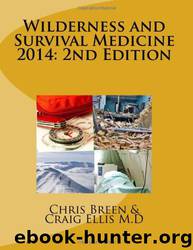Wilderness and Survival Medicine 2014: 2nd Edition by Chris Breen

Author:Chris Breen [Breen, Chris]
Language: eng
Format: epub
ISBN: 9781493720033
Amazon: 1493720031
Publisher: CreateSpace Independent Publishing Platform
Published: 2013-11-11T05:00:00+00:00
Chapter 27 Medication
Introduction Within this section is information on common useful medication. Most are available only with a prescription, those freely available over the counter are marked (OTC), Those that can be dispensed by a Pharmacist are marked (P) and any Controlled Drugs are marked (CD) .
It is beyond the scope of this book to go into detail on each drug, so information leaflets must be studied carefully and it is recommended you also purchase a reliable up to date Pharmacy Book, In the UK the British National Formulary (BNF) is published twice a year and is an excellent resource. If you ask you local chemists they may have some old ones they will give away.
Medicines are described here in generic context – specific applications of specific drugs are described in relation to specific conditions.
How medicines work Pharmaceutical science is a huge subject, before any drug is taken or administered both parties need to have knowledge of its use, side effects, interactions and contra-indications. Patients with other existing conditions or who are taking other medication must be particularly careful when starting new ones. Both parties need also be vigilant in case serious side effects occur and know how to counter them.
A basic understanding of how medications is important to their safe use in a remote or remote situation.
Pharmacology is the study of how drugs work. It can be broadly divided into:
Pharmaceutics (“what is it?” i.e. preparation, packaging, storage, reconstitution, etc). Pharmacokinetics (what the body does to the drug)
Pharmacodynamics (what the drug does to the body)
Indications and contraindications (when you do/do not use it) 1.Pharmaceutics:
Drugs come in various forms. These can be natural, unprocessed raw materials (e.g. willow bark for aspirin, tobacco leaves for nicotine), powders, liquids, tablets, capsules or gasses. These can be further divided into those ready for use (e.g. tablets to be swallowed “as is”) or powders for reconstitution before use (some children’s medicines to be mixed with clean water to form a liquid suspension).
Some powders will dissolve well in the right solvent, whilst others will form a chalky mixture which needs to be shaken well immediately before use. For this reason, certain drugs will also need specific solvents (e.g. Alcohol vs. water. Iodine will not dissolve well in water, so it is made as a “tincture”, which is an alcoholic solution).
Some liquids will dilute well with solvents, while others are made as an emulsion (fatty globules of drug suspended in water, making a milky appearance, such as the anaesthetic drug propofol).
Most of the decisions of a drug’s form will depend on considerations such as shelf life, cost, ease of use, and physicochemical properties such as whether it is an acid/base, an oil-soluble or water-soluble compound and likely size of dose to be used.
It is important that drugs not be mixed without knowing what will happen. For example, Lignocaine (a local anaesthetic drug) is dissolved in a weak acid solution, owing to the drug’s own pKa (its’ tendency to act like an acid)*. Thiopentone (a general anaesthetic drug) is a highly alkaline solution.
Download
This site does not store any files on its server. We only index and link to content provided by other sites. Please contact the content providers to delete copyright contents if any and email us, we'll remove relevant links or contents immediately.
The Art of Coaching by Elena Aguilar(52210)
Thinking, Fast and Slow by Kahneman Daniel(11804)
The Art of Thinking Clearly by Rolf Dobelli(9930)
The 5 Love Languages: The Secret to Love That Lasts by Gary Chapman(9295)
Mindhunter: Inside the FBI's Elite Serial Crime Unit by John E. Douglas & Mark Olshaker(8722)
When Breath Becomes Air by Paul Kalanithi(8045)
Periodization Training for Sports by Tudor Bompa(7929)
Becoming Supernatural by Dr. Joe Dispenza(7845)
Turbulence by E. J. Noyes(7717)
Bodyweight Strength Training by Jay Cardiello(7681)
Therapeutic Modalities for Musculoskeletal Injuries, 4E by Craig R. Denegar & Ethan Saliba & Susan Saliba(7601)
The Road Less Traveled by M. Scott Peck(7284)
Nudge - Improving Decisions about Health, Wealth, and Happiness by Thaler Sunstein(7261)
Mastermind: How to Think Like Sherlock Holmes by Maria Konnikova(6944)
Enlightenment Now: The Case for Reason, Science, Humanism, and Progress by Steven Pinker(6879)
Win Bigly by Scott Adams(6833)
Kaplan MCAT General Chemistry Review by Kaplan(6605)
Why We Sleep: Unlocking the Power of Sleep and Dreams by Matthew Walker(6366)
The Way of Zen by Alan W. Watts(6292)
